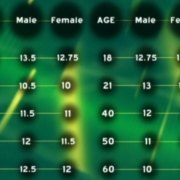Tennis Specific Endurance Test
In this post I introduce a couple of Tennis Specific Endurance tests.
As I explain in the video above there is a big difference between running in a straight line and running sideways with a tennis racket in your hand. They require different physical qualities. Below is a summary of some of the traditional performance tests I have used, or currently use. I finish by giving some examples of some drills that could be used instead of traditional straight ahead running drills to test tennis specific anaerobic qualities.
Aerobic Performance Tests
At APA we currently use the Yo-yo Intermittent recovery Level 1 test to determine endurance in our Tennis players.
I used to use the bleep test but switched to the Yo-yo around 5 years ago as I liked the intermittent nature of the test. I am considering using the 30-15 Intermittent Fitness test but haven’t done this as of yet.
For a comprehensive review of the tests and their pros and cons you can check out Science for Sport.
My thoughts?
I wanted to use an endurance test that challenged an athlete’s change of direction so any of the tests I have already mentioned tick that box. I moved away from the bleep test because that was a continuous test. The yo-yo test is an intermittent test run over a distance of 20m, with a 10-seconds walking rest. I like this because the time it takes to run 20m there and back and the time they have to rest are well matched to the demands of tennis.
I am tempted to move to the 30-15 test because the athletes are covering 40m and keep going for 30-seconds- which in my opinion makes this harder. So if the goal is to match the demands of the sport I think I’ll stick with the Yo-yo as 20m is a more suitable distance than 40m. But if you want to choose the hardest test- which will ask some questions of their will power to go through some pain- you might want to try the 30-15.
Anaerobic Performance Tests
Running-Based Anaerobic Sprint Test (RAST)
Developed in the UK in 1997 by Draper and Whyte (1) at the University of Wolverhampton, the Running-Based Anaerobic Sprint Test (RAST) is a testing protocol designed to measure anaerobic power and capacity (2). The test involves six sprints over a 35-meter distance, with a 10-second recovery between each sprint. Due to its accuracy as a test and its simplicity, the RAST is commonly used by exercise professionals to monitor performance.
This is a running based test, running 35m straight and then having a 10-second recovery. It might take 4-5 seconds to do the 35m. So you’re looking at a work to rest ratio of 1:2.
What about Sport Specific Anaerobic Performance tests?
As I show in the video above, there are a number of drills you could do to test anaerobic endurance qualities- all of them are based on First Step Speed Endurance. This may give you further insights into an athlete’a ability to endure more sport specific movements.
Drill 1 Figure 8 (Lateral)
Work for 10-30 seconds: Rest for 10-30 seconds- you can determine the work and rest intervals that work best for your needs. I like to do 10-seconds of work and 30-seconds rest, and 3 rounds
Drill 2 Figure 8 (Forward)
Work for 10-30 seconds: Rest for 10-30 seconds- you can determine the work and rest intervals that work best for your needs. I like to do 20-seconds of work and 30-seconds rest, and 3 rounds
Drill 3 Forehand drill
Work for 10-30 seconds: Rest for 10-30 seconds- you can determine the work and rest intervals that work best for your needs. I like to do 30-seconds of work and 30-seconds rest, and 3 rounds.
With drill 3 and drill 4 you can count as follows.
The athlete starts the movement with the left foot on the centre mark on the baseline (if moving to the right hand side). The athlete scores ‘1’ every time they run to shadow a forehand in line with the cone and return to the start position. You can award marks as follows:
0.25 if they get half way out to cone
0.50 if they get out to cone and complete the stroke
0.75 if after the stroke they get half way back
1.00 if after the stroke they get all the way back
Drill 4 Backhand drill
Work for 10-30 seconds: Rest for 10-30 seconds- you can determine the work and rest intervals that work best for your needs. I like to do 30-seconds of work and 30-seconds rest, and 3 rounds. Below are some targets for different age groups, based on data from Pat Etcheberry.
Drill 5 Service box shuttles
Work for 10-30 seconds: Rest for 10-30 seconds- you can determine the work and rest intervals that work best for your needs. I like to do 30-seconds of work and 30-seconds rest, and 3 rounds
Remember:
- If you’re not subscribed yet, click here to get free email updates, so we can stay in touch.
- Share this post using the buttons on the top and bottom of the post. As one of this blog’s first readers, I’m not just hoping you’ll tell your friends about it. I’m counting on it.
- Leave a comment, telling me where you’re struggling and how I can help
Since you’re here…
…we have a small favor to ask. APA aim to bring you compelling content from the world of sports science and coaching. We are devoted to making athletes fitter, faster and stronger so they can excel in sport. Please take a moment to share the articles on social media, engage the authors with questions and comments below, and link to articles when appropriate if you have a blog or participate on forums of related topics. — APA TEAM







